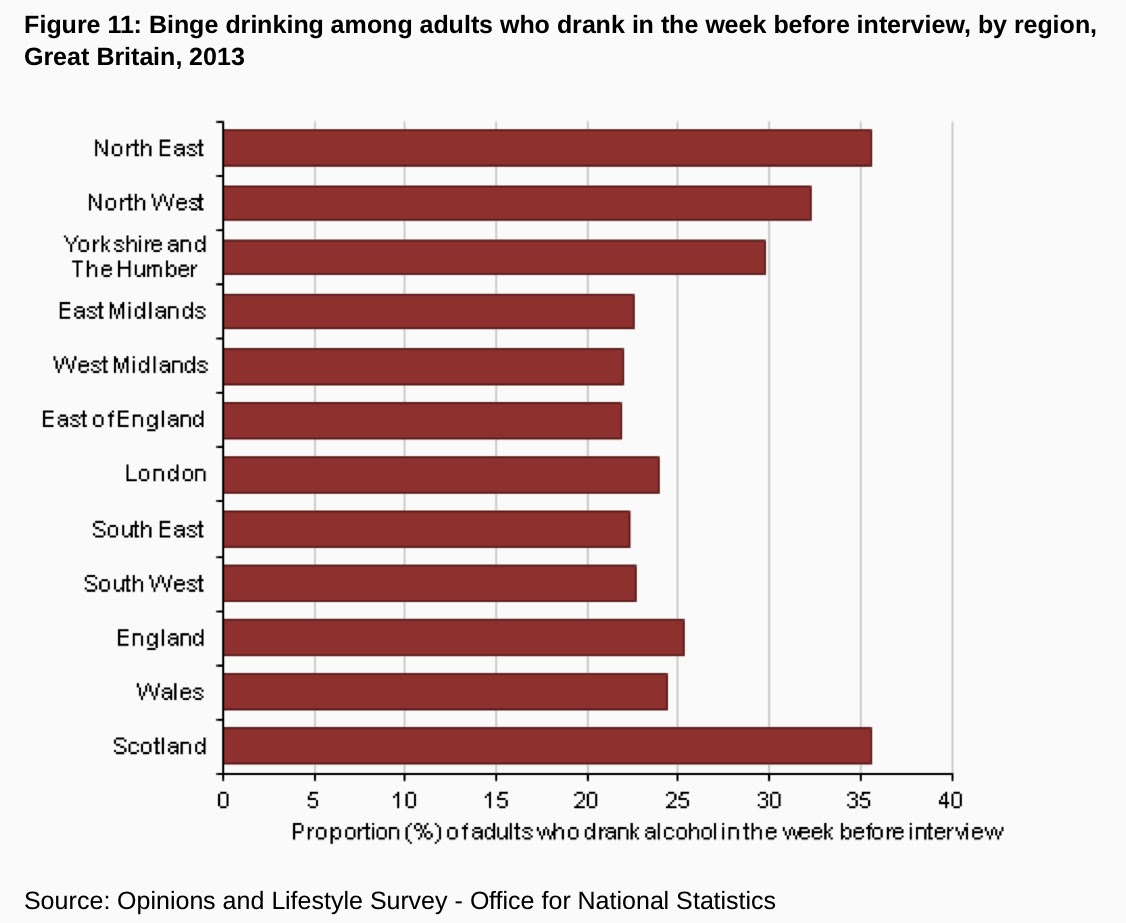The authors looked at alcohol consumption and alcohol-related deaths in various British regions and concluded that...
We have confirmed the ecological relationship between consumption and harm; alcohol-related mortality rates are generally higher in regions with higher per adult consumption.
This claim is based on the following graph which charts alcohol consumption (horizontal) against alcohol-related mortality (vertical):
There is supposed to be a correlation here, but it is clearly very weak. Indeed, the authors note that the correlation is "r =0.59, 95% confidence interval (CI) = -0.02 to 0.89" which means that it is statistically insignificant. It is a sign of how low standards have sunk in 'public health' that the authors do not even mention statistical significance, let alone concede that their correlation doesn't pass the test. Instead, they argue that the correlation would be stronger if it wasn't for the pesky South West dragging things down on the right-hand side. They then come up with some rather desperate excuses for why this region has a high rate of alcohol consumption but about the same rate of alcohol-related mortality as London, the place with the lowest alcohol consumption. Bizarrely, they say that tourism is a "likely explanation" (ie. people from other parts of the country drinking in the West country and going home to die of liver cirrhosis). Perhaps they think that Edinburgh doesn't get tourists, or that its tourists don't buy lots of whisky to drink and/or take home with them?
All this graph really shows is that alcohol consumption and related morality is low in London and high in central Scotland (Glasgow, Edinburgh etc.). There isn't a statistically significant correlation between the two variables and there isn't even a hint of a correlation if one only looks at England. But the authors are wedded to the Total Consumption Model, so they have to treat the South West as a paradox to be explained away.
I didn't bother to write about this study when it came out because it's just another piece of trash in the vast dustbin of policy-based evidence and I am but one man. However, it came to mind again last week when the Office for National Statistics published its latest data on drinking habits. Amongst the data was this chart showing the prevalence of teetotalism in each region.
As you can see, the South West has the lowest prevalence of teetotalism in Britain. So, whilst the region drinks more than any other on a per capita basis, it does not necessarily drink more or a per drinker basis, let alone on a per problem drinker basis.
In fact, we have no idea how many problem drinkers there are in any of these regions, nor do we know how much they drink. We do have some evidence about so-called 'binge-drinking' (defined as 8 units or more in any given day for men and 6 units for women). Here it is...
This chart shows that rates of binge-drinking are highest in Scotland, the North East and the North West. This tallies somewhat with the evidence in the BMC Public Health study insofar as it is these regions that have the highest rates of alcohol-related mortality.
It's not difficult to see how a high prevalence of binge-drinkers could result in a higher rate of alcohol consumption, but it is also not difficult to see how an area like the South West could have a high rate of per capita alcohol consumption without the rates of harm that would be expected from the simplistic Total Consumption Model. It is a region in which a large proportion of the population drinks, but drinks relatively moderately and—presumably—regularly.
To the authors of the BMC Public Health study, this may seem like an explanation of the South West 'paradox'. In fact, it is just one example of different populations behaving in different ways. There is no paradox and the South West is not the outlier.
The outlier is central Scotland because it is the only area that has conspicuously higher rates of alcohol-related mortality. Why is this? Perhaps partly because of the high rates of binge-drinking shown in the chart above. But, as the experience of the South West shows, it is not the consequence of its per capita alcohol consumption. Per capita alcohol consumption is the consequence of other factors. It could be the consequence of lots of people drinking a moderate amount or it could be the consequence of relatively few people drinking a great deal. Simply looking at per capita consumption tells you nothing about the underlying factors and, contrary to the Total Consumption Model, it can therefore predict nothing.




3 comments:
So this shows that Glaswegians are pissed up and Londoners are boring teetotalers. Sounds right to me!
And from the Daily Telegraph this morning:
Simon Stevens: tackling cheap booze is urgent priority
The head of the NHS is calling for increases in the price of cheap alcohol
amid warnings that heavy drinking is taking a “huge” toll on Accident &
Emergency departments.
http://www.telegraph.co.uk/news/uknews/11420596/Simon-Stevens-tackling-cheap-booze-is-urgent-priority.html
Another crusader who wants to 'help' us. How sweet.
Mr Stevens said heavy drinking and soaring levels of sugar consumption by the
British public were now two of the most urgent health problems facing the
nation
Of course. Now that they have all but exterminated smokers and vapers ...
Post a Comment